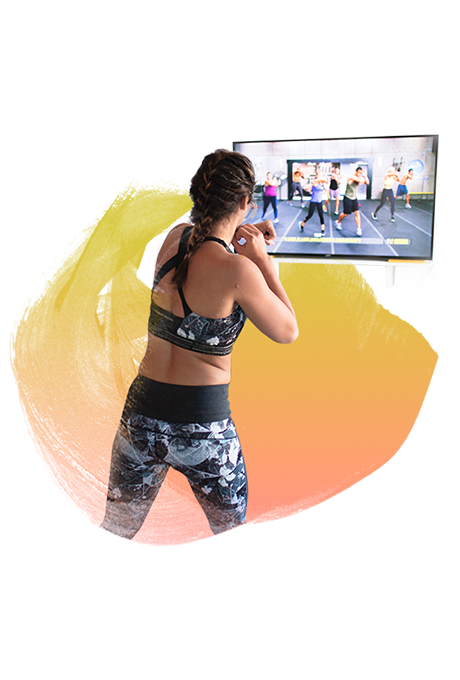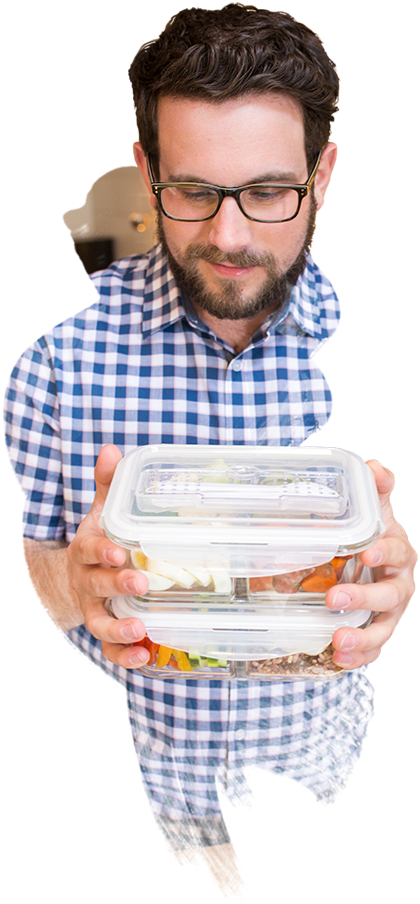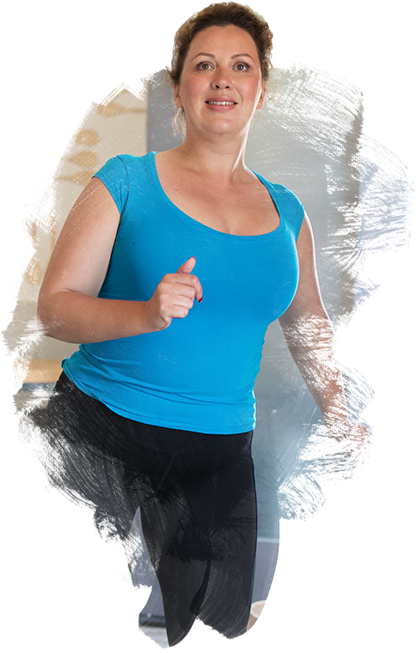BEACHBODY’S ULTIMATE GUIDE TO WEIGHT LOSS: CHAPTER 5

Can exercise help you
LOSE WEIGHT?
While diet has been the most oft-cited tool for losing weight as of late, it’s important not to neglect other lifestyle changes. Chief among them: increasing physical activity. Research shows that combining diet and exercise leads to greater weight loss than either alone. What’s more, studies demonstrate that the weight can stay off in the long run when we commit to a regular exercise program.
Cutting 600 calories from your daily intake may feel like a lot, as might burning 600 calories through exercise. But, what if you cut 300 calories and burned 300 calories? That offers a more approachable solution.
Whether you’re walking, following 21 Day Fix, or lifting weights, these all contribute to stronger muscles and bones. Exercise is championed for its mood-boosting effects; it enhances self-esteem, and helps us sleep better at night. All of these can help with weight loss.
Can Exercise Help You
LOSE WEIGHT?

BEACHBODY’S GUIDE TO WEIGHT LOSS: CH 5
Chapter 1: Can’t Lose Weight?
Chapter 2: How to Start
Chapter 3: Make it Easier
Chapter 4: What to Eat
Chapter 5: Weight Loss Workouts
Chapter 6: Maintain My Weight Loss
While diet has been the most oft-cited tool for losing weight as of late, it’s important not to neglect other lifestyle changes. Chief among them: increasing physical activity. Research shows that combining diet and exercise leads to greater weight loss than either alone. What’s more, studies demonstrate that the weight can stay off in the long run when we commit to a regular exercise program.
Cutting 600 calories from your daily intake may feel like a lot, as might burning 600 calories through exercise. But, what if you cut 300 calories and burned 300 calories? That offers a more approachable solution.
Whether you’re walking, following 21 Day Fix, or lifting weights, these all contribute to stronger muscles and bones. Exercise is championed for its mood-boosting effects; it enhances self-esteem, and helps us sleep better at night. All of these can help with weight loss.
Can’t Lose Weight? | How to Start | Make it Easier | What to Eat | Weight Loss Workouts | Maintain My Weight Loss
HOW YOUR WORKOUTS
Impact Weight Loss
The health-boosting power of exercise is no secret. It can help reduce symptoms associated with depression, help you manage stress, and help you maintain overall good health. Aerobic training can even prompt neurogenesis in the brain, and the latest research suggests that 150 minutes or more of moderate physical activity a week can add 3.4 to 4.5 years to your life.
With all that said, there’s been buzz lately regarding how weight loss is achieved more efficiently through diet, and that exercise alone won’t help you shed pounds. Surely the millions of people who credit working out with helping them lose weight didn’t imagine those decreasing numbers on the scale. A primer on how the body burns energy (calories) can help clear up any confusion.
HOW YOUR
WORKOUTS
Impact Weight Loss
The health-boosting power of exercise is no secret. It can help reduce symptoms associated with depression, help you manage stress, and help you maintain overall good health. Aerobic training can even prompt neurogenesis in the brain, and the latest research suggests that 150 minutes or more of moderate physical activity a week can add 3.4 to 4.5 years to your life.
With all that said, there’s been buzz lately regarding how weight loss is achieved more efficiently through diet, and that exercise alone won’t help you shed pounds. Surely the millions of people who credit working out with helping them lose weight didn’t imagine those decreasing numbers on the scale. A primer on how the body burns energy (calories) can help clear up any confusion.
The Best Weight Loss Workouts
While a huge variety of workouts have been shown to contribute to good health, when it comes to weight loss, strength training and high-intensity interval training (HIIT) come out on top. Not only do these workouts burn calories, but they also usually require a greater degree of metabolic and muscular recovery, which contributes to the after-burn effect.
Boosting your BMR becomes especially important as you age because it naturally declines over the years. A study published in Current Sports Medicine Reports showed that inactive adults lose between three to eight percent of muscle mass per decade accompanied by a slowing metabolism and fat accumulation. Research has demonstrated that resistance training can raise your basal metabolic rate, which as was mentioned earlier, means you’ll burn more calories recovering from that workout even while sitting at your desk.
Just 10 weeks of resistance training has been shown to increase resting metabolic rate by seven percent and reduce body fat.


The Best Weight Loss Workouts
While a huge variety of workouts have been shown to contribute to good health, when it comes to weight loss, strength training and high-intensity interval training (HIIT) come out on top. Not only do these workouts burn calories, but they also usually require a greater degree of metabolic and muscular recovery, which contributes to the after-burn effect.
Boosting your BMR becomes especially important as you age because it naturally declines over the years. A study published in Current Sports Medicine Reports showed that inactive adults lose between three to eight percent of muscle mass per decade accompanied by a slowing metabolism and fat accumulation. Research has demonstrated that resistance training can raise your basal metabolic rate, which as was mentioned earlier, means you’ll burn more calories recovering from that workout even while sitting at your desk.
Just 10 weeks of resistance training has been shown to increase resting metabolic rate by seven percent and reduce body fat.
Research has also shown that a few months of resistance training twice a week has the potential to increase overall strength and decrease body fat even without dietary restrictions.
The other exercise that deserves major kudos for igniting weight loss is HIIT. This can include a wide variety of workout types — from sprint intervals to circuit training — all which involve short bursts of high-intensity effort followed by short periods of recovery. If you’ve ever done a bootcamp-style class, CrossFit, or many of the programs available on Beachbody on Demand, you’re likely already familiar with it.
One of the big reasons you’ll love HIIT workouts is that it will help you lose fat. Indeed, a study published in Metabolism demonstrated that shorter, high-intensity sessions lead to more fat loss than lower-intensity work. What’s more, research suggests that harder workouts prompt an enhanced post-workout calorie burn when compared to more moderate-intensity workouts. That said, if you’re just beginning your fitness journey, you should start with lower to moderate intensity workouts, and work your way up to HIIT to avoid overtraining.
Research has also shown that a few months of resistance training twice a week has the potential to increase overall strength and decrease body fat even without dietary restrictions.
The other exercise that deserves major kudos for igniting weight loss is HIIT. This can include a wide variety of workout types — from sprint intervals to circuit training — all which involve short bursts of high-intensity effort followed by short periods of recovery. If you’ve ever done a bootcamp-style class, CrossFit, or many of the programs available on Beachbody on Demand, you’re likely already familiar with it.
One of the big reasons you’ll love HIIT workouts is that it will help you lose fat. Indeed, a study published in Metabolism demonstrated that shorter, high-intensity sessions lead to more fat loss than lower-intensity work. What’s more, research suggests that harder workouts prompt an enhanced post-workout calorie burn when compared to more moderate-intensity workouts. That said, if you’re just beginning your fitness journey, you should start with lower to moderate intensity workouts, and work your way up to HIIT to avoid overtraining.

How Many Calories You Need to Burn to Lose Weight
The human body burns calories in three main ways. First, there is your basal metabolic rate, which is the energy required to keep your body functioning (i.e., heart beating, blood pumping, lungs breathing, kidneys filtering, etc.) at rest. Next, there is dietary thermogenesis, which is the energy expended to metabolize what you eat. Finally, there are the calories you burn through exercise and activity.
At the end of the day, the sum of these three will equal your total calorie burn or total daily energy expenditure (TDEE).
Interestingly, while we obviously burn calories during workouts, it is the basal metabolic rate (BMR) that gets the most attention when it comes to burning calories. Genetics, age, gender, and body composition are among the factors that determine your BMR, which makes up a whopping 70 percent of your TDEE.
Research shows that certain types of exercise have a more pronounced and long-lasting impact on BMR (the study referenced here shows the impact that strength training has on older adults with naturally slowing metabolisms), thereby allowing you to burn more calories when you’re at rest. The reason that strength training has such a significant effect on basal metabolic rate — especially when compared to steady state cardio — is that it triggers a recovery process that can last up to 72 hours. Recovery requires energy, and when you’re not exercising (i.e., when you don’t need to produce as much energy as possible as quickly as possible) your body prefers to tap your fat stores to meet those increased energy needs. Talk about more bang for your buck.
So how many calories do you need to burn to lose weight? Put simply, it depends. A number of factors influence your caloric needs, but if you’re looking for a general answer, consider this: You need to create a calorie deficit. In other words, you simply need to burn more calories than you take in each day.

How Many Calories You Need to Burn to Lose Weight
The human body burns calories in three main ways. First, there is your basal metabolic rate, which is the energy required to keep your body functioning (i.e., heart beating, blood pumping, lungs breathing, kidneys filtering, etc.) at rest. Next, there is dietary thermogenesis, which is the energy expended to metabolize what you eat. Finally, there are the calories you burn through exercise and activity.
At the end of the day, the sum of these three will equal your total calorie burn or total daily energy expenditure (TDEE).
Interestingly, while we obviously burn calories during workouts, it is the basal metabolic rate (BMR) that gets the most attention when it comes to burning calories. Genetics, age, gender, and body composition are among the factors that determine your BMR, which makes up a whopping 70 percent of your TDEE.
Research shows that certain types of exercise have a more pronounced and long-lasting impact on BMR (the study referenced here shows the impact that strength training has on older adults with naturally slowing metabolisms), thereby allowing you to burn more calories when you’re at rest. The reason that strength training has such a significant effect on basal metabolic rate — especially when compared to steady state cardio — is that it triggers a recovery process that can last up to 72 hours. Recovery requires energy, and when you’re not exercising (i.e., when you don’t need to produce as much energy as possible as quickly as possible) your body prefers to tap your fat stores to meet those increased energy needs. Talk about more bang for your buck.
So how many calories do you need to burn to lose weight? Put simply, it depends. A number of factors influence your caloric needs, but if you’re looking for a general answer, consider this: You need to create a calorie deficit. In other words, you simply need to burn more calories than you take in each day.
How Much Exercise Is Enough for Weight Loss?
So now that you know which weight loss workouts are most effective, you might be wondering how often you need to partake in these activities. While the answer will be somewhat different for everyone, it’s important to keep in mind that moderation is key, especially at the beginning of your weight-loss journey.
Both strength sessions and HIIT cause micro-trauma (damage on the cellular level) to your muscles, so it’s important to take recovery days. That’s why low-intensity cardio is still a good thing to intersperse into your weekly routine; it serves as activity recovery, boosting blood flow and thereby helping to speed muscle repair and metabolic waste removal. Plus, you’ll burn a few more calories while your at it, making it a twofer.
How often does one need to strength train different parts of the body in order to increase lean mass and strength? The American College of Sports Medicine recommends that beginners get in two or three days per week of strength training with a day of rest between sessions, and there’s research to back that up.
One study that compared one, two, and three sessions per week where participants trained the major muscle groups with eight to 12 repetitions of each exercise. Over the course of 10 weeks, all participants benefited, but those who did two or three sessions per week added more than three times the amount of lean muscle mass than the one-day-per-week group.


How Much Exercise
Is Enough for Weight Loss?
So now that you know which weight loss workouts are most effective, you might be wondering how often you need to partake in these activities. While the answer will be somewhat different for everyone, it’s important to keep in mind that moderation is key, especially at the beginning of your weight-loss journey.
Both strength sessions and HIIT cause micro-trauma (damage on the cellular level) to your muscles, so it’s important to take recovery days. That’s why low-intensity cardio is still a good thing to intersperse into your weekly routine; it serves as activity recovery, boosting blood flow and thereby helping to speed muscle repair and metabolic waste removal. Plus, you’ll burn a few more calories while your at it, making it a twofer.
How often does one need to strength train different parts of the body in order to increase lean mass and strength? The American College of Sports Medicine recommends that beginners get in two or three days per week of strength training with a day of rest between sessions, and there’s research to back that up.
One study that compared one, two, and three sessions per week where participants trained the major muscle groups with eight to 12 repetitions of each exercise. Over the course of 10 weeks, all participants benefited, but those who did two or three sessions per week added more than three times the amount of lean muscle mass than the one-day-per-week group.
Some of the same principles apply to HIIT, namely, more is not necessarily better. If you try to take on too much of this type of high-intensity (and sometimes high impact) work, you could end up hitting a wall of injury and fatigue if you’re not accustomed to the physical demands of these types of workouts.
For most people, at least three HIIT sessions per week will help boost fitness and fat loss. If you’re new to this kind of workout, it’s a good idea to start with fewer days and work your way up as you get into shape.
If designing your own workout schedule seems daunting, Beachbody on Demand offers several programs that combine HIIT, strength training, and active recovery. Check out 22 Minute Hard Corps, INSANITY: MAX 30, and CORE DE FORCE.
Some of the same principles apply to HIIT, namely, more is not necessarily better. If you try to take on too much of this type of high-intensity (and sometimes high impact) work, you could end up hitting a wall of injury and fatigue if you’re not accustomed to the physical demands of these types of workouts.
For most people, at least three HIIT sessions per week will help boost fitness and fat loss. If you’re new to this kind of workout, it’s a good idea to start with fewer days and work your way up as you get into shape.
If designing your own workout schedule seems daunting, Beachbody on Demand offers several programs that combine HIIT, strength training, and active recovery. Check out 22 Minute Hard Corps, INSANITY: MAX 30, and CORE DE FORCE.

Fuel Your Workouts Without Overeating
While optimal performance during your workouts necessitates adequate calorie intake, some people over-do their eating when they start a new exercise regimen—especially if they begin with lower-intensity workouts. research points to the “hunger hormone” ghrelin as a possible culprit.
One study found that cycling at various intensities and durations led to an increase in ghrelin. Researchers concluded that low rather than high-intensity exercise stimulates ghrelin levels, no matter how long the workout lasts.
With that said, you’ll need to be selective about what you eat in order to support the increased physical activity and lose weight.
To be sure, starving yourself is not the answer.

Fuel Your Workouts
Without Overeating
While optimal performance during your workouts necessitates adequate calorie intake, some people over-do their eating when they start a new exercise regimen—especially if they begin with lower-intensity workouts. research points to the “hunger hormone” ghrelin as a possible culprit.
One study found that cycling at various intensities and durations led to an increase in ghrelin. Researchers concluded that low rather than high-intensity exercise stimulates ghrelin levels, no matter how long the workout lasts.
With that said, you’ll need to be selective about what you eat in order to support the increased physical activity and lose weight.
To be sure, starving yourself is not the answer.
For instance, one study discovered that strength training athletes who reduced calorie intake by 30 percent didn’t experience a change in muscle mass, while those who cut it by 19 percent increased their muscle mass and got leaner.
While you’ll need to reduce your total daily calorie intake to lose body fat, you’ll want to focus on getting nutrient-dense, high-quality calories to change your body composition. The Beachbody Portion Fix Eating Plan can help simplify the often complicated process of figuring out what and how much to eat.
So how do you know how many calories you should take in? If you find yourself getting truly hungry frequently, it might be time to look at your intake, and add in some protein and fiber. Using a nutrition app or writing down your food intake can help you get a bigger picture of your dietary landscape.
Remember: All calories are not created equal. Four hundred calories of a grilled chicken salad is a much healthier option than a 400-calorie bowl of ice cream. The healthier option will not only help you avoid packing on fat, but it’ll also better fuel your workouts.
Follow these quick tips to help control your appetite as you start a new workout plan.
For instance, one study discovered that strength training athletes who reduced calorie intake by 30 percent didn’t experience a change in muscle mass, while those who cut it by 19 percent increased their muscle mass and got leaner.
While you’ll need to reduce your total daily calorie intake to lose body fat, you’ll want to focus on getting nutrient-dense, high-quality calories to change your body composition. The Beachbody Portion Fix Eating Plan can help simplify the often complicated process of figuring out what and how much to eat.
So how do you know how many calories you should take in? If you find yourself getting truly hungry frequently, it might be time to look at your intake, and add in some protein and fiber. Using a nutrition app or writing down your food intake can help you get a bigger picture of your dietary landscape.
Remember: All calories are not created equal. Four hundred calories of a grilled chicken salad is a much healthier option than a 400-calorie bowl of ice cream. The healthier option will not only help you avoid packing on fat, but it’ll also better fuel your workouts.
Follow these quick tips to help control your appetite as you start a new workout plan.
3 Ways to Manage Appetite
- Eat mindfully. It’s hard to trust your gut unless you are aware of what your body is telling you. Pay attention to physical cues to help you determine when you’re eating out of hunger and when you’re heading to the fridge out of boredom. Even the experts at Harvard Medical School are prescribing this approach to help people lose weight.
- Increase protein. Research published in the American Journal of Clinical Nutrition shows that combining high-intensity interval training and strength training six days a week with high-protein intake can help boost muscle gain and fat loss. Study participants who consumed 2.4 grams of protein per kilogram (or about 1.1 grams of protein per pound ) of bodyweight per day improved their body composition (lost fat and increased muscle) most effectively.
- Time your meals right. The American Council on Exercise recommends taking in a higher carbohydrate meal with a bit of protein a few hours before you do a high intensity interval workout. Try oatmeal with peanut butter and a banana. After your workout, a shake that contains protein and a small amount of carbs, such as Beachbody Performance Recover, is your best bet for optimizing recovery and muscle growth.


3 Ways to Manage Appetite
- Eat mindfully. It’s hard to trust your gut unless you are aware of what your body is telling you. Pay attention to physical cues to help you determine when you’re eating out of hunger and when you’re heading to the fridge out of boredom. Even the experts at Harvard Medical School are prescribing this approach to help people lose weight.
- Increase protein. Research published in the American Journal of Clinical Nutrition shows that combining high-intensity interval training and strength training six days a week with high-protein intake can help boost muscle gain and fat loss. Study participants who consumed 2.4 grams of protein per kilogram (or about 1.1 grams of protein per pound ) of bodyweight per day improved their body composition (lost fat and increased muscle) most effectively.
- Time your meals right. The American Council on Exercise recommends taking in a higher carbohydrate meal with a bit of protein a few hours before you do a high intensity interval workout. Try oatmeal with peanut butter and a banana. After your workout, a shake that contains protein and a small amount of carbs, such as Beachbody Performance Recover, is your best bet for optimizing recovery and muscle growth.

Start Your Weight Loss Workouts
If you’re just jumping into a new routine, finding time in your busy schedule can be one of your biggest hurdles. That’s why at-home workouts are a great place to start. No need to drive to the gym and navigate a sweaty locker room — just throw on your workout clothes and burn some calories in your living room. Check out Beachbody on Demand to find the best workout for you.

Start Your Weight Loss
Workouts
If you’re just jumping into a new routine, finding time in your busy schedule can be one of your biggest hurdles. That’s why at-home workouts are a great place to start. No need to drive to the gym and navigate a sweaty locker room — just throw on your workout clothes and burn some calories in your living room. Check out Beachbody on Demand to find the best workout for you.


